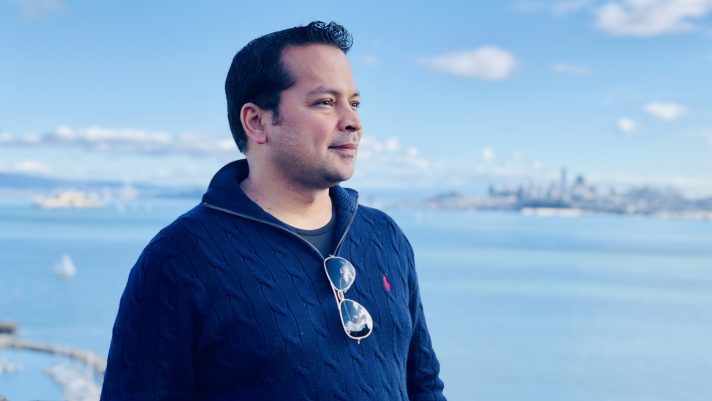It’s a well-known principle of life that the more you give the more you’ll receive, and this has been profoundly experienced by our worldwide community of Transcendental Meditation teachers.
We are incredibly grateful to every one of our teachers, for taking the time and resources to become certified through our 5 month, in-residence TM teacher training course, and for dedicating themselves, whether full or part-time, to helping others find peace and happiness within. Without our network of trained teachers, we wouldn’t be able to share this beautiful technique with the world.
In our latest interview we connect with a new TM teacher, Utsav Bajgain, who, like many others, made a drastic career change to pursue a dream of helping others by teaching Transcendental Meditation.
— What motivated you to leave your successful career at Panasonic to become a TM teacher?
Before I learned the TM technique, I was experiencing burnout, anxiety, and depression. I was coping with alcohol and chain smoking. After TM, not only were anxiety, depression, and burnout gone, but I also had so much energy and creativity to achieve wonders at work and became very creative and a very dynamic problem solver. I found clarity and purpose in life. Essentially, my life flipped for good. And I felt this calling to share this transformative tool with everyone.
Everywhere I go, I see people suffering from high stress, anxiety, and symptoms of mental health conditions. Firstly, I could not help but think how I could bring this technique to those in need. Secondly, until recently, my life was all about taking from situations and circumstances. But, then it became more about giving. So, out of my desire to give back to communities and help people overcome mental health challenges, I decided to become a TM teacher.
— How long have you been practicing the Transcendental Meditation technique and what inspired you to learn?
I have been practicing the TM technique for 8+ years. My mother had been doing different kinds of meditation for a long time until she learned TM in 2010. It really intrigued me when my mother became regular with her TM practice. I got inspired when she expressed how easy the technique is. Then I watched some videos of Maharishi–the founder– online. His emphasis on consciousness and his contagious laughter drew me to listen to him more. The more I listened to him, the more sense I made of life – life is bliss.
— What was your perception of meditation in general before you took the TM course? Did that perception change after your first few experiences meditating?
Meditation is a household term in Nepal and India. Everyone knows about it but, ironically, few practice it regularly. I was also taking it for granted. I understood meditation to be a very difficult process in which one has to empty the mind and that it could only be done by recluses, sages, saints, monks, hermits, and those who have detached themselves from social and family life.
When I attended a TM intro talk, my teacher, Jos Jacobs, said it is very easy and effortless. The word effortless brought it home for me. Then after practicing TM just 20 minutes twice a day, it gave me a taste of what monks experience while keeping my hustling work and family life. The TM technique gives me a very profound and powerful experience twice a day–and it is so easy. I never thought meditation could be so easy, practical, and doable in daily life.
— Talk about the biggest failure you’ve had. What did you learn from it?
My biggest failure in life was not prioritizing self-care and my own mental health. I wish I had learned the TM technique in my teens. If I had, I could have avoided the anxiety and depression I experienced. I learned from such failures to never de-prioritize my own mental health and self-care. You can only give when your own cup is full. The biggest thing you can give to the world is your own best, original, and authentic self.
— What’s your greatest success, and what did you learn from it?
Being a Nepali immigrant in the U.S. and Japan felt like being a salmon swimming against the current, with grizzly bears waiting to pounce on you. Despite obstacles in the form of bias, discrimination, and power harassment in the workplace, I hustled, persisted, and found creative ways to get a manager position with a six-figure income at a Fortune 50 company.
I attribute this success to my philosophy of continuous improvement. That is, make tiny little organic improvements every day, and retrospectively, I realize I have come a long way without making too much of a fuss. In this way, I move forward despite the obstacles. I learned that no accomplishment is easy. Whatever change I want to bring, whatever originality unfolds, whatever unique value proposition I want to offer the world, there will be a lot of obstacles. But, I’ve learned that obstacles become the path when I have a tool like the TM technique that gives me the experience of infinite, unbounded awareness within.
— What do you want to accomplish next?
I want to be one of the most influential proponents of mental health awareness. We are going through a phase transition, and there could not be a better timing than this to reshuffle and prioritize sustainability, holistic health, and emphasis on consciousness over imbalanced accumulation of wealth. The first, immediate, critical step should be to make everyone aware of mental health issues they are going through. Moreover, removing the stigma of mental illness is also of prime importance. This vision could materialize as a wellness consultancy start up and/or a wellness company offering Consciousness-basedSM health solutions, integrative medicine (naturopathic medicine and Ayurvedic medicine), Transcendental Meditation, etc.
Coming from the automotive industry, I also want to be a proponent of electrification of the car and autonomous driving. This vision could materialize a startup company that makes electric cars for a niche market segment like low speed neighborhood pods.
— What are your 3 favorite “tools” for a healthy, happy life?
Meditation: This is extremely important for me to anchor myself into pure awareness and not get bogged down by the stresses of life.
Balanced, nutritious food: As body and mind influence each other, healthy, balanced and nutritious food gives me optimum energy to plunge into action and be more creative. We are what we eat.
Physical activity: Most helpful for me is walking a couple miles in the woods every day. This integrates the deep silence from meditating twice daily and allows me to focus sharply on my creative work.
After 10+ years of making his way to the top of his field as a business consultant, at Japanese companies such as Panasonic, Utsav Bajgain realized there was a more fulfilling path in life as a Transcendental Meditation teacher. He’s now a full time, certified TM teacher based in Everett, WA and aims to bring the inner peace and happiness of the TM technique to corporations, veterans organizations, hospitals and universities. If you’d like to connect with him, he can be reached at ubajgain@tm.org or the Everett TM Center.





